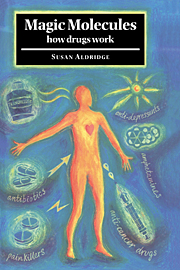Book contents
- Frontmatter
- Contents
- List of illustrations
- Acknowledgements
- Introduction
- 1 How drugs work
- 2 From penicillin to Prozac: introducing pharmaceutical drugs
- 3 Fighting infection
- 4 The hormonal revolution
- 5 Cardiovascular drugs: protecting the heart and brain
- 6 The problem of pain
- 7 The cancer challenge
- 8 Drugs for the mind
- 9 Drugs of recreation and addiction
- 10 Natural alternatives: vitamins, minerals and herbs
- 11 In the pipeline: gene-based medicine
- Bibliography
- Index
1 - How drugs work
Published online by Cambridge University Press: 05 August 2012
- Frontmatter
- Contents
- List of illustrations
- Acknowledgements
- Introduction
- 1 How drugs work
- 2 From penicillin to Prozac: introducing pharmaceutical drugs
- 3 Fighting infection
- 4 The hormonal revolution
- 5 Cardiovascular drugs: protecting the heart and brain
- 6 The problem of pain
- 7 The cancer challenge
- 8 Drugs for the mind
- 9 Drugs of recreation and addiction
- 10 Natural alternatives: vitamins, minerals and herbs
- 11 In the pipeline: gene-based medicine
- Bibliography
- Index
Summary
Glaring lights. Noise. Traffic congestion. Looming deadlines. None of it life-threatening, but enough to start up your body's favourite stress response – a tension headache. Muscles in your neck and scalp tighten, perhaps constricting nearby blood vessels. The affected tissue starts to produce chemicals called prostaglandins. These act on nearby nerve endings which, in turn, send messages to the brain producing the sensation of pain.
It may not be the best long-term solution (maybe you should give up that stressful job or take up yoga) but a couple of soluble aspirin tablets will kill that headache in about half an hour, by turning off prostaglandin production. The same goes for other everyday irritations such as toothache, menstrual cramps and rheumatic aches and pains.
Swallowing a dose of aspirin releases about two thousand million million million (2 X 1021) pain-relieving molecules into the body. They won't all reach their target (the site of prostaglandin production), but experience of the drug over nearly 100 years has shown that this dose – around 600 milligrams – is enough to take care of most tension headaches.
The aspirin molecules first have to negotiate the digestive system to get into the bloodstream, which will carry them to the site of the pain (Fig. 1.1). The digestive system is basically a tube going from the mouth to the anus. It filters any molecules which enter it (food or drugs, that is) according to their size and chemical structure. Small, fat-soluble molecules pass easily though the walls of the small intestine into the bloodstream. Larger molecules such as proteins, fats and carbohydrates (the basic components of food) are chewed up into smaller fragments by the powerful acid juices of the stomach and the digestive enzymes produced by the stomach and pancreas.
- Type
- Chapter
- Information
- Magic MoleculesHow Drugs Work, pp. 1 - 22Publisher: Cambridge University PressPrint publication year: 1998



